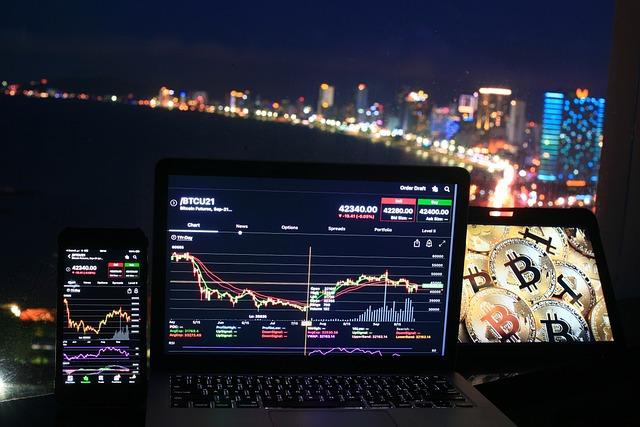On October 19, 1987, the sun rose over Wall Street, casting long shadows on the bustling traders below. As the day unfolded, whispers of rising interest rates and geopolitical tensions spread like wildfire. Panic set in when automated trading systems, designed to protect investments, instead triggered a cascade of sell orders. Stocks plummeted, and the market lost over 22% in a single day. By sunset, the once-thriving exchange was left in stunned silence, a stark reminder of how swiftly confidence can crumble in the face of uncertainty.
Table of Contents
- Understanding the Economic Landscape Leading to Black Monday
- The Role of Speculation and Market Psychology in the Crash
- Analyzing Regulatory Oversights and Their Impact on Market Stability
- Strategies for Future Resilience: Lessons Learned from Black Monday
- Q&A

Understanding the Economic Landscape Leading to Black Monday
The economic environment leading up to that fateful day was characterized by a confluence of factors that created a perfect storm for market instability. **Rising interest rates** had begun to dampen consumer spending, while **inflationary pressures** were mounting, causing uncertainty among investors. The stock market had been on a prolonged bull run, with many believing that the upward trajectory was unsustainable. This optimism was further fueled by **speculative trading**, where investors were increasingly buying stocks on margin, amplifying their exposure to potential losses. As the market reached new heights, the underlying economic indicators began to signal a shift, yet many remained oblivious to the brewing storm.
Additionally, the global economic landscape played a crucial role in shaping investor sentiment. **Geopolitical tensions** and trade disputes were escalating, leading to fears of a slowdown in international trade. The **oil crisis** of the late 1970s had left lingering effects, with fluctuating oil prices impacting various sectors. As news of economic instability spread, panic began to set in among investors, prompting a wave of sell-offs. The interconnectedness of global markets meant that a downturn in one region could quickly ripple across the world, and as confidence eroded, the stage was set for a dramatic market correction that would come to be known as Black Monday.
The Role of Speculation and Market Psychology in the Crash
The events leading up to Black Monday were heavily influenced by the interplay of speculation and market psychology. Investors, driven by a mix of optimism and fear, began to engage in speculative trading, often ignoring fundamental valuations. This behavior created a bubble-like atmosphere where prices soared based on sentiment rather than solid financial performance. As the market reached unprecedented heights, many traders felt an overwhelming sense of euphoria, leading to a collective belief that the upward trend would continue indefinitely. However, this optimism was precarious, resting on shaky foundations that could easily crumble under pressure.
As whispers of economic instability began to circulate, the mood shifted dramatically. The psychology of the market turned from exuberance to panic almost overnight. Investors, fearing a downturn, rushed to sell their holdings, triggering a domino effect that exacerbated the decline. Key factors contributing to this shift included:
- Media Influence: Sensational headlines amplified fears and uncertainties.
- Herd Behavior: Many investors followed the crowd, leading to a mass exodus from the market.
- Algorithmic Trading: Automated systems exacerbated the sell-off, reacting to market signals without human intervention.
This combination of speculative fervor and sudden shifts in market psychology ultimately culminated in the catastrophic events of Black Monday, illustrating how sentiment can drive financial markets to extremes.

Analyzing Regulatory Oversights and Their Impact on Market Stability
The events leading up to Black Monday on October 19, 1987, were marked by a series of regulatory oversights that contributed significantly to the market’s instability. **Market deregulation** during the 1980s allowed for unprecedented levels of trading activity, but it also created an environment ripe for volatility. The absence of stringent oversight meant that many financial instruments, particularly derivatives, were traded without adequate risk assessment. This lack of regulation led to a **cascade of sell orders** as investors reacted to falling prices, exacerbating the market’s decline. The reliance on automated trading systems further amplified the situation, as these systems executed trades at lightning speed, often without human intervention to assess the broader implications of their actions.
Moreover, the **inadequate response** from regulatory bodies during the initial stages of the crash highlighted the systemic weaknesses in the financial infrastructure. The Securities and Exchange Commission (SEC) was slow to implement measures that could have mitigated the panic, such as halting trading or providing liquidity support. As a result, the market experienced a **loss of confidence**, not only among institutional investors but also among the general public. The aftermath of Black Monday prompted a reevaluation of regulatory frameworks, leading to the introduction of new measures aimed at enhancing market stability and preventing similar occurrences in the future. This pivotal moment in financial history serves as a reminder of the critical role that effective regulation plays in maintaining market integrity.
Strategies for Future Resilience: Lessons Learned from Black Monday
In the wake of Black Monday, it became evident that financial markets require robust frameworks to withstand sudden shocks. One of the key lessons learned is the importance of **diversification**. Investors and institutions alike should spread their assets across various sectors and geographies to mitigate risks associated with market volatility. Additionally, the implementation of **automated trading systems** must be approached with caution. While these systems can enhance efficiency, they can also exacerbate market downturns if not properly regulated and monitored. Establishing clear guidelines for algorithmic trading can help prevent cascading sell-offs during periods of panic.
Another critical strategy is the enhancement of **communication channels** among market participants. During Black Monday, a lack of transparency and timely information contributed to widespread uncertainty. By fostering an environment where information flows freely and swiftly, stakeholders can make informed decisions, reducing the likelihood of panic selling. Furthermore, **stress testing** financial institutions to evaluate their resilience against extreme market conditions can provide valuable insights. Regular assessments can help identify vulnerabilities and ensure that contingency plans are in place, ultimately strengthening the overall stability of the financial system.
Q&A
-
What is Black Monday?
Black Monday refers to October 19, 1987, when stock markets around the world crashed, with the Dow Jones Industrial Average falling by over 22% in a single day.
-
What were the main causes of Black Monday?
The crash was attributed to a combination of factors, including:
- Program Trading: Automated trading programs triggered massive sell-offs.
- Market Psychology: Investor panic and fear led to a herd mentality.
- Economic Concerns: Rising interest rates and a weakening dollar raised alarms.
-
How did global markets react to Black Monday?
Global markets experienced significant declines, with many countries’ stock exchanges following the U.S. lead, resulting in a worldwide financial crisis.
-
What were the long-term effects of Black Monday?
The crash led to regulatory changes, including the introduction of trading curbs and improved market surveillance to prevent future crashes.
As we reflect on the events of Black Monday, it becomes clear that a confluence of factors—market speculation, economic shifts, and investor psychology—shaped this pivotal moment. Understanding these elements helps us navigate the complexities of financial markets today.

大家好,我是彼得潘,專業的手法身體治療師。我喜歡探索和研究各種主題,並透過與人工智慧的合作分享專業、實用、有趣的文章。我們定期進行人工審核,以確保內容的準確性。如果您發現文章中有任何不準確的地方,請隨時與我們聯繫,我們會及時糾正。您可以透過 [email protected] 與我們聯繫。



